

12 Math Facts. Activities – Mathigon. Timeline of Mathematics Travel though time and discover the greatest mathematicians and biggest mathematical discoveries in history.

Polypad The ultimate collection of virtual manipulatives: polygons, number and algebra tiles, fraction bars, Tangram, pentominoes, and much more. Mathematical Origami Explore the beautiful world of Origami and mathematics. Applications of Mathematics Learn about the countless hidden applications which mathematics has in everyday life: from computers to weather prediction, video games, medicine, sports and music. Problems and Puzzles. Algebra - 1-(1x2)+1-(2x3)+1-(3x4)...+1-(n(n+1)) Hi Hossun.
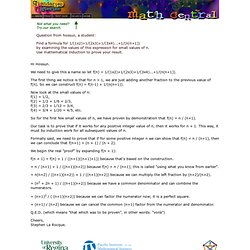
Algebra - More Notes. Art of Problem Solving. Aspect Ratios in Photography. This article is written by Andrew S.

Gibson, the author of Square. Today I’d like to draw your attention to an area of composition that you might not have given much thought to: aspect ratio. Aspect ratio is the term used to describe the dimensions of an image by comparing the width to the height and expressing it in ratio form. The aspect ratio of your images is primarily determined by the dimensions of your camera’s sensor (or the film type plus camera design with film cameras). Best Statistics Question Ever. CEMC - Math Circles. The Waterloo Math Circles is a free weekly enrichment activity for grade 6 to 12 students organized by the Faculty of Mathematics of the University of Waterloo.
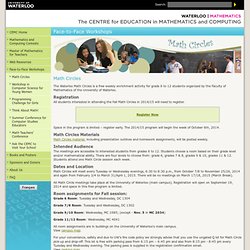
Registration All students interested in attending the Fall Math Circles in 2014/15 will need to register. Space in the program is limited – register early. The 2014/15 program will begin the week of October 6th, 2014. Math Circles Materials. Canadian Mathematical Society. Dave's Short Trig Course. Table of Contents.
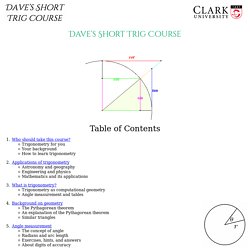
Difference Between a Percentage and a Rate (as explained by medical field) Often we hear the question, "What is the difference between a percentage and a rate?

" They are both calculated using a numerator and a denominator. However, the relationship between the numerator and denominator makes the difference. Percentages Indicators which use percentage are the most commonly used indicator type in healthcare. Most of the Joint Commission measures monitor percentages to measure compliance. Fields Institute - Math Circles. NEWS 2014: Math Circles Instructors wanted!
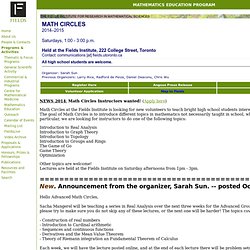
(Apply here) Math Circles at the Fields Institute is looking for new volunteers to teach bright high school students interesting topics in mathematics. The goal of Math Circles is to introduce different topics in mathematics not necessarily taught in school, while keeping things fun! In particular, we are looking for instructors to do one of the following topics: Introduction to Real Analysis Introduction to Graph Theory Introduction to Topology Introduction to Groups and Rings The Game of Go Game Theory Optimization Other topics are welcome! Hello Advanced Math Circles, Free Stock Market Game, Create Your Own Contest. Ed Barbeau. Lattice Multiplication. Linear Equations (modeling) Math as Artistry. I have a treat for readers today, an interview I did recently with Steven Strogatz, mathematician and writer on math extraordinaire.
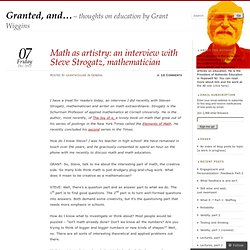
Strogatz is the Schurman Professor of applied mathematics at Cornell University. Mathematical Association of America. Mathematica - Let's shape together the mathematicians of the future /// Byron-Germain, Fibonacci, Pythagore, Euler and Lagrange Contests. All Mathematica Centrum contests will be written on April 28, 2021.

We are still accepting registrations for the April 28th, 2021 contests. To register your school call 514-626-4406. If you wish to purchase questionnaires of past contests, please click here The 2020 Contests and Preparatory Tests are both available, please click here. Further details will be forthcoming. Mathologer. MathsStarters - a great start to your maths lesson.
MindYourDecisions. Multiplication Strategies. Nth term of sequence. National Museum of Mathematics. Quadrilaterals In Depth. There are many different kinds of quadrilaterals, but all have several things in common: all of them have four sides, are coplanar, have two diagonals, and the sum of their four interior angles equals 360 degrees.
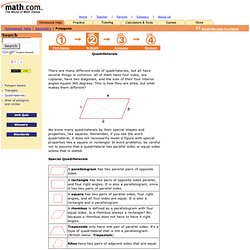
This is how they are alike, but what makes them different? We know many quadrilaterals by their special shapes and properties, like squares. Remember, if you see the word quadrilateral, it does not necessarily mean a figure with special properties like a square or rectangle! In word problems, be careful not to assume that a quadrilateral has parallel sides or equal sides unless that is stated.
Special Quadrilaterals. Short Problems for Practice and Revision. Similar Triangles Applications. Image Source: A powerful Zoom lens for a 35mm camera can be very expensive, because it actually contains a number of highly precise glass lenses, which need to be moved by a tiny motor into very exact positions as the camera auto focuses. The Geometry and Mathematics of these lenses is very involved, and they cannot be simply mass produced and tested by computer robots.
Lots of effort required to manufacture these lenses results in their very high price tags. Here is a diagram showing how the zoom lens internal arrangement changes as we zoom from 18mmm wide angle to 200mm fully zoomed in: Image Source: Image Copyright 2013 by Passy’s World of Mathematics Shown above are some band photographs taken by Passy with a special low light camera. Some Mathematical GIFs. Here are some GIFs I have collected over internet that explain mathematical ideas. The following GIF explain what is meant by tangent/parallel lines and asymptotes. The following GIF explains how to construct a regular heptagon using straight edge and compass. The following 2 GIFs explain what an ellipse is and how to draw it. The area of the circle with unit radius is. Solar System Model in Nevada Desert. Stats: Binomial Probabilities. Binomial Experiment A binomial experiment is an experiment which satisfies these four conditions A fixed number of trials Each trial is independent of the others There are only two outcomes The probability of each outcome remains constant from trial to trial.
These can be summarized as: An experiment with a fixed number of independent trials, each of which can only have two possible outcomes. The fact that each trial is independent actually means that the probabilities remain constant. Examples of binomial experiments. Teaching a Stock Market Simulation, Lesson Plan, Game. Stocks, the stock market, business, the economy.
This lesson plan may be used by anyone, without any prior stock market or investing knowledge. In addition, we are available to answer any questions you may have either when beginning this lesson, or questions you may have during this exercise. Text analysis of Trump's tweets confirms he writes only the (angrier) Android half. The Math Circle. The Unexpected Math behind Van Gogh's "Starry Night". A few lesson plans exist for teaching visual arts and self-similarity (objects that have the same pattern) that could be used after showing this lesson. Visual Patterns. Wolfram.